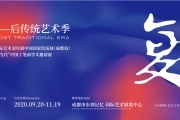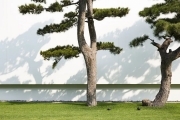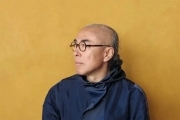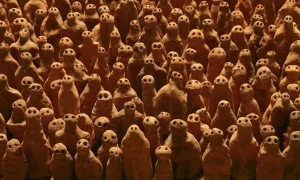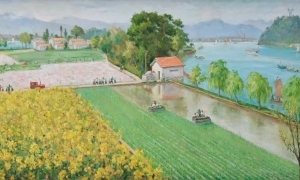摄影术是为着记录客观真实的目的而发明的,但在使用这个媒介,尤其是用它作为艺术表现的媒介时,却首先会发现摄影并不完全是客观真实的记录手段。摄影只能框取天上人间大千世界中一定宽和一定长的某个局部,这既是它的局限又使得它因此能强调某一部分景物的重要性及其隐含的寓意;摄影只能定格流动着的时间中的一瞬,但它使这一瞬变成了永恒。黑白摄影是不真实的,但它又使缤纷的五彩世界抽象地转化为黑白灰,呈现给我们一个异样的世界,给我们一份惊喜。
摄影的不真实不仅由于技术层面上的原因,更多的还因为我们拍摄时的主观选择。当我们举起照像机试图去拍摄一个场景的时候,我们肯定是在运用某一种观念在指导我们的手指,否则我们为什么会对着这一个场景而不是另一个场景,是在这一瞬间而不是在另一瞬间按下快门?即使是毫无目的的拍摄,也隐藏着某种观念,也许旨在表明“我们的主观选择是错误的,我们要抛弃它”这样一种观念。只要是摄影就离不开选择,而所有的选择都是跟我们的主观有关联的,都是为某种观念所引导,从这个意义上来说,所有的摄影都是观念摄影,都带着不真实的主观的以至于强迫的色彩。反过来讲,再怎么观念的作品,都是用照像机和胶片在记录下某种设定的场景,或者是从生活中截取的一个片断,即使改头换面到难以辨认的程度,它总是客观生活的一个翻版和记录,从这个意义上来说,所有的摄影包括我们现在所指的观念摄影都是带有某种记录性的。只不过为了讨论问题的方便起见,我们把摄影用并不精确的词语作了分类,分成纪实摄影、观念摄影等等,这是我们所使用的语言的缺陷,而在我们思考问题的时候,是绝对不能把两者截然分开,甚至相互对立。正是摄影的这种将客观记录和主观选择结合在一起的既矛盾又统一的特征加强了摄影作品的表现力度。我们借此或直截了当或曲折含蓄地表达了那些虽然用语言等其它媒介也能表达但不够全面,或者根本无法用语言来传达的思想、观念和情感,这就是摄影的力量所在。
摄影作品的尺寸原本不必专门提出来讨论,小幅精致,大幅气派,萝卜青菜各有所好。但当代艺术的发展使得摄影作品的尺寸不仅是大小问题,而且已成为某种美学问题,这就值得我们关注了。现代艺术中照片的尺寸越来越大,这多少是被大型的艺术展览给逼出来的,因为在20世纪六、七十年代以前,大部分的摄影作品是在所谓的摄影沙龙里展出,规模小,观众也很陶醉于小幅作品精致的影调表现;再者,手工制作大型作品的难度很大,尤其对于大部分不谙此道的艺术家来说更是如此。20世纪六、七十年代以后,以摄影为媒介的艺术作品大量进入美术馆,面对美术博物馆巨大的墙壁和在同一个空间里展出的巨幅绘画、装置和雕塑作品,摄影作品迫切需要扩大它的体量。在八、九十年代以后,随着数码打印技术的发展,印制大幅照片已经成为轻而易举的事情,作品的尺寸骤然膨胀。当作品做大不成问题的时候,具体做到多大,什么样的图像质量能为人接受便成了问题。
有一部分艺术家不在乎传统意义上的图像质量,或者虽然在乎但能力有限无法兼顾,可以说这样的图像是被“撑大”的,但这批作品只要寓意深刻都已经被默认了;另有一部分艺术家坚持使用大型相机,较大的底片尺寸使得照片即使在二三米以上也有传统意义上的影像质量,如Jeff Wall, Andreas Gursky, Thomas Ruff的作品,并发展出一种新的摄影语言:即“预先设想”这样的作品是在一个大的展览空间里以大尺幅的形式为观众所观看,照片上所有的细节都会被依次看到,因而这样的照片在拍摄当初就已经考虑到最终的观看效果。与前面一种照片被“撑大”之后的观看效果会变差正相反,这类照片在缩小(如印刷品)时会损失很多细节,以致于影响意义的表达。如Thomas Ruff的作品在印刷品里就像一张证件照,何奇之有?但熊掌与鱼不可得兼,艺术家只能选择其一,如果说小幅照片在看过印刷质量上乘的画册之后就能领略其大概,再看原作不会有太多的惊喜;那么大幅照片则只能看原作,相信观众自会有许多发现和心得。这既是对作者辛苦劳动的回报,又对得起参观展览的观众,否则费时费力,车马劳累,大老远的跑到展览会上去干什么?
Artist’s Statement for the exhibition
Between Past and Future-New Photography and Video from China(2004-2007)
Miao Xiaochun
Photography was invented for the purpose of recording objective truth. However, while using this medium, especially using it as a medium of artistic expression, one will discover that photography does not completely record reality. Any photograph can only depict a certain section of the world, with a certain width and a certain length. This is not to be considered solely a limitation, for it can be used to emphasize the importance of a part of the scene and its implied meanings. Photography can only record a split-second record of time; nevertheless, it makes that second eternal. A black-and-white photograph may be untruthful, but it transforms the colorful world into black, white, and gray in an abstract way, presents us with an unusual view of the world, and can bring us much joy.
Photography’s untruthfulness arises primarily from our subjective choices. When we hold up a camera to photograph a scene, it is guaranteed that some concept is guiding our fingers. Otherwise, why is this scene, and not another scene, to be photographed? Why is the shutter pushed down at this split second and not another? Even a photograph taken without any obvious purpose might express the concept that subjective choice is wrong and should be abandoned. Choice is always involved. From this perspective, all photography is conceptual photography. On the other hand, even if a photograph is a conceptual work; it still records something with camera and film. Even if the appearance is changed and it is difficult to recognize, it still records something in the world. Thus all photography, including our so-called conceptual photography, is at one level documentary. We only divide photography into inaccurate categories for the convenience of discussion; in actuality these two cannot be separated, nor are they antagonistic. Photography combines objective recording and subjective choice, which intensifies the expressive power of the work. We use this feature to either directly or indirectly express thoughts and feelings that might only be incompletely expressed by language or through some other media, or that cannot be expressed by language at all. This is the power of photography.
It may not seem necessary to discuss the size of photographic work. Small ones are delicate, large ones are striking, and each scale is unique in its own ways. But it has become an aesthetic issue that needs close attention. Today photographs are getting bigger and bigger, a phenomenon prompted in part by large exhibitions. In the 1960s and 1970s, most photographic work was displayed in so-called photography salons, where delicate photographs were appreciated and praised. Moreover, it was difficult to produce large photographs. Later a vast amount of photo-based artwork entered art galleries. With gigantic painting, installations, and sculptures displayed within vast museums, photographic work was driven to enlarge its size and volume. After the emergence of digital printing in the 1980s and 1990s, this became an easier task. All of a sudden, photographs were huge. The questions then became: how big is big, and what kind of image quality is acceptable for an audience?
Some artists do not care too much about image quality in a traditional sense, or if they do care, they do not have the ability to deal with both scale and quality. This kind of work is already accepted as long as it is meaningful. Other artists insist on using large cameras and negatives, which results in high image quality in the traditional sense even though the resulting photographs are over two or three meters. The works of Jeff Wall, Andreas Gursky, and Thomas Ruff are of this kind. A new photographic language is developed, and such photographs will probably be displayed to an audience in gigantic galleries where all their fine details can be seen. In this sense, the end result of this kind of photograph is already known while the work is still nascent. This is the exact opposite of “expanded” photographs with a poor image quality. Small reproductions of this kind of photograph will lose a lot of detail, even effect the expression of meanings. But you cannot have both, and artists need to decide which one they want. If an audience already knows the meaning of a small photograph after seeing the good-quality reproduction, then seeing the original work afterward will not bring much joy; for large photographs, it is better to see the originals. This is the return to an artist’s hard work, and also to the pleasure of being part of the audience. Otherwise, why go out of your way to see an art exhibition?
【编辑:小红】




